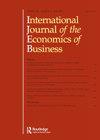各国应对COVID-191的最终成绩单
IF 0.9
Q3 BUSINESS
International Journal of the Economics of Business
Pub Date : 2023-02-24
DOI:10.1080/13571516.2023.2176636
引用次数: 0
摘要
两年半前,COVID-19传播到美国。遵循联邦制模式(New State Ice Co.诉Liebmann;Cheng, Chen, and Christopher Lee, 2019。民主的实验室:权力下放下的政策实验。《经济研究》(3):1 - 4。doi: 10.1257 / mic.20160257。[Crossref], [Web of Science®],[Google Scholar]), 50个州及其州长和立法者做出了许多自己的流行病政策选择,以减轻病毒的损害。随着时间的推移,各国相互了解哪些政策在遏制病毒方面最有效,哪些政策最无效,同时最大限度地减少封锁战略对企业和儿童的负面影响。本研究是2020年10月报告卡的扩展和更新版本,该报告卡显示了50个州和哥伦比亚特区的大流行卫生、经济和政策如何变化(2020年释放繁荣委员会)。“给我们的州长评分:重新开放各州经济的成绩单。”https://committeetounleashprosperity.com/wp-content/uploads/2020/10/Governors-Report-Card-Updated1.pdf [Google Scholar])。它审查了三个变量:健康结果、疫情期间的经济表现以及对教育的影响。我们发现大流行期间经济活动减少与死亡率之间没有关系。本文章由计算机程序翻译,如有差异,请以英文原文为准。
A Final Report Card on the States’ Response to COVID-191
Two and a half years ago COVID-19 spread to the United States. Following the federalism model (New State Ice Co. vs Liebmann; Cheng and Lee 2019 Cheng, Chen, and Christopher Lee. 2019. Laboratories of Democracy: Policy Experimentation under Decentralization. American Economic Journal: Microeconomics 11 (3): 125–154. doi:10.1257/mic.20160257.[Crossref], [Web of Science ®] , [Google Scholar]), the 50 states and their governors and legislators made many of their own pandemic policy choices to mitigate the damage from the virus. States learned from one another over time about what policies worked most and least effectively in terms of containing the virus while minimizing the negative effects of lockdown strategies on businesses and children.This study is an expanded and updated version of an October 2020 report card of how pandemic health, economy, and policy varied across the 50 states and the District of Columbia (Committee to Unleash Prosperity 2020 Committee to Unleash Prosperity. 2020. “Grading Our Governors: A Report Card on Reopening States’ Economies.” https://committeetounleashprosperity.com/wp-content/uploads/2020/10/Governors-Report-Card-Updated1.pdf [Google Scholar]). It examines three variables: health outcomes, economic performance throughout the pandemic, and impact on education. We find no relationship between reduced economic activity during the pandemic and mortality.
求助全文
通过发布文献求助,成功后即可免费获取论文全文。
去求助
来源期刊
CiteScore
2.60
自引率
8.30%
发文量
9
期刊介绍:
International Journal of the Economics of Business presents original, peer reviewed research in economics that is clearly applicable to business or related public policy problems or issues. The term "business" is used in its widest sense to encompass both public and private sector—governmental, private non-profit and cooperative organizations, as well as profit-seeking enterprises. International Journal of the Economics of Business carries papers relating to three main spheres: The organization—to analyse and aid decision making and the internal organization of the business; The industry—to analyse how businesses interact and evolve within and across industries.

 求助内容:
求助内容: 应助结果提醒方式:
应助结果提醒方式:


